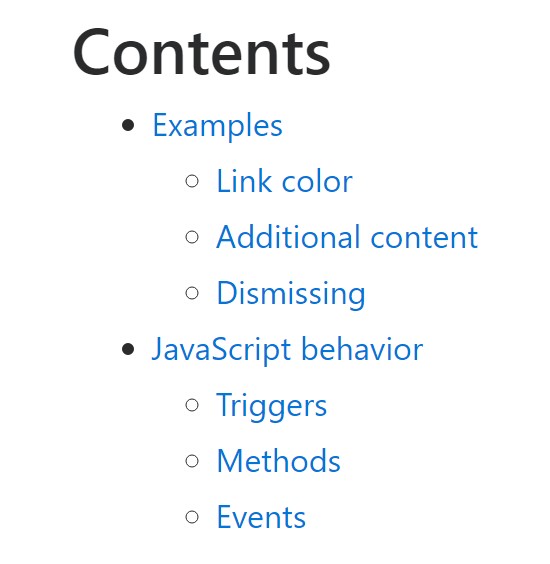Bootstrap Alert Warning
Overview
The alerts are offered by all these components you even usually do not think of until you extremely get to really need them. They are put to use for presenting prompt in time comments for the user interacting with the site hopefully aiming his or hers focus to a specific direction or evoking special actions.
The alerts are most commonly used along with forms to give the user a recommendation if a field has been completed incorrectly, which is the proper format expected or which is the status of the submission as soon as the submit button has been pressed.
As a lot of the elements in the Bootstrap framework the alerts also do have a neat predefined look and semantic classes that may possibly be used according the particular condition where the Bootstrap Alert has been displayed on display. Due to the fact that it's an alert message it is very important to obtain user's interest but however keep him in the zone of comfort nevertheless it might even be an error notification. ( additional reading)
This gets achieved by use of light toned color tones each being intuitively attached to the semantic of the message information just like green for Success, Light Blue for regular information, Light yellow aiming for user's attention and Mild red revealing there is really something wrong.
<div class="alert alert-success" role="alert">
<strong>Well done!</strong> You successfully read this important alert message.
</div>
<div class="alert alert-info" role="alert">
<strong>Heads up!</strong> This alert needs your attention, but it's not super important.
</div>
<div class="alert alert-warning" role="alert">
<strong>Warning!</strong> Better check yourself, you're not looking too good.
</div>
<div class="alert alert-danger" role="alert">
<strong>Oh snap!</strong> Change a few things up and try submitting again.
</div>Colour of the url
It really may possibly not be noticed at a quick look but the font colour itself is actually following this coloration too-- just the color options are much much darker so get subconsciously takened as dark but the truth is it's not exactly so.
Exact same works not only for the alert text message itself but at the same time for the links included in it-- there are link classes taking off the outline and coloring the anchor elements in the appropriate color so they suit the overall alert message look.

<div class="alert alert-success" role="alert">
<strong>Well done!</strong> You successfully read <a href="#" class="alert-link">this important alert message</a>.
</div>
<div class="alert alert-info" role="alert">
<strong>Heads up!</strong> This <a href="#" class="alert-link">alert needs your attention</a>, but it's not super important.
</div>
<div class="alert alert-warning" role="alert">
<strong>Warning!</strong> Better check yourself, you're <a href="#" class="alert-link">not looking too good</a>.
</div>
<div class="alert alert-danger" role="alert">
<strong>Oh snap!</strong> <a href="#" class="alert-link">Change a few things up</a> and try submitting again.
</div>Special details for alerts
A aspect to keep in mind-- the colours bring their clear interpretation only for those who in fact get to notice them. And so it's a good thing to either ensure the detectable text message itself offers the meaning of the alert well enough or to eventually add a number of additional explanations to only be seen by the screen readers in order to provide the page's accessibility .
In addition to links and simple HTML tags like strong as an example the alert elements in Bootstrap 4 can also include Headings and paragraphs for the situations when you desire to showcase a bit longer information ( read here).

<div class="alert alert-success" role="alert">
<h4 class="alert-heading">Well done!</h4>
<p>Aww yeah, you successfully read this important alert message. This example text is going to run a bit longer so that you can see how spacing within an alert works with this kind of content.</p>
<p class="mb-0">Whenever you need to, be sure to use margin utilities to keep things nice and tidy.</p>
</div>Decline the alert
You can as well put in an X icon to dismiss the alert and provide a cool transition to it to one more time ensure the visual comfort of the Bootstrap Alert Tutorial visitors.

<div class="alert alert-warning alert-dismissible fade show" role="alert">
<button type="button" class="close" data-dismiss="alert" aria-label="Close">
<span aria-hidden="true">×</span>
</button>
<strong>Holy guacamole!</strong> You should check in on some of those fields below.
</div>Currently there are four varieties of contextual alert messages in Bootstrap 4 framework - they are named Success, Info, Warning and Danger. Do not allow however their titles to decrease the way you're using them-- all of these are simply some color schemes and the method they will be actually performed in your website is completely up to you and completely depends on the special scenario.
For example-- if the color design of your page makes use of the red as basic colour it may be quite well-suited to show the alert for successful form submission in red too making use of the predefined alert danger appearance in order to much better blend with the page and save time specifying your own classes.
After all the predefined alert classes are nothing but some consistent appearances and the responsibility for using them lays entirely on the designer's shoulders.
JavaScript role of the Bootstrap Alert Colors
Triggers
Enable termination of an alert by using JavaScript
$(".alert").alert()Enable dismissal of an alert via JavaScript
Or with information features on a button located in the alert, as indicated mentioned earlier
<button type="button" class="close" data-dismiss="alert" aria-label="Close">
<span aria-hidden="true">×</span>
</button>Take note that shutting off an alert will remove it from the DOM.
Options
$().alert()$().alert('close')Events
Bootstrap's alert plugin exposes a handful of events for fastening right into alert features.
close.bs.alertclosed.bs.alertTake a look at a few online video short training regarding Bootstrap alerts
Related topics:
Bootstrap alerts main records

W3schools:Bootstrap alert tutorial

Bootstrap Alert Issue

